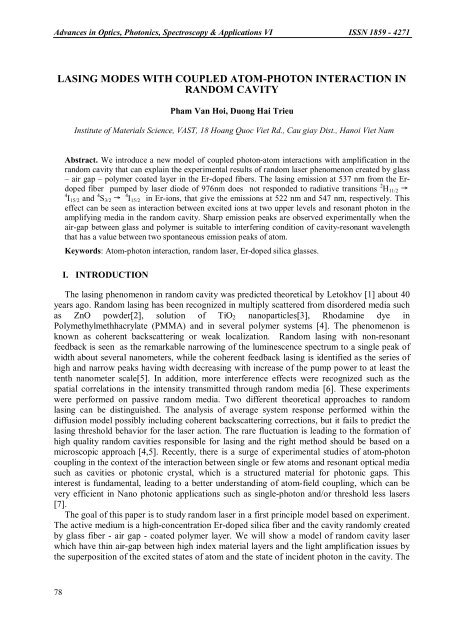Nhng tin b trong Quang hc, Quang ph và ng dng VI ISSN 1859 - 4271
Nhng tin b trong Quang hc, Quang ph và ng dng VI ISSN 1859 - 4271
Nhng tin b trong Quang hc, Quang ph và ng dng VI ISSN 1859 - 4271
Create successful ePaper yourself
Turn your PDF publications into a flip-book with our unique Google optimized e-Paper software.
Advances in Optics, Photonics, Spectroscopy & Applications <strong>VI</strong> <strong>ISSN</strong> <strong>1859</strong> - <strong>4271</strong>LASING MODES WITH COUPLED ATOM-PHOTON INTERACTION INRANDOM CA<strong>VI</strong>TYPham Van Hoi, Duo<strong>ng</strong> Hai TrieuInstitute of Materials Science, VAST, 18 Hoa<strong>ng</strong> Quoc Viet Rd., Cau giay Dist., Hanoi Viet NamAbstract. We introduce a new model of coupled <stro<strong>ng</strong>>ph</stro<strong>ng</strong>>oton-atom interactions with amplification in therandom cavity that can explain the experimental results of random laser <stro<strong>ng</strong>>ph</stro<strong>ng</strong>>enomenon created by glass– air gap – polymer coated layer in the Er-doped fibers. The lasi<strong>ng</strong> emission at 537 nm from the Erdopedfiber pumped by laser diode of 976nm does not responded to radiative transitions 2 H 11/2 →4 I 15/2 and 4 S 3/2 → 4 I 15/2 in Er-ions, that give the emissions at 522 nm and 547 nm, respectively. Thiseffect can be seen as interaction between excited ions at two upper levels and resonant <stro<strong>ng</strong>>ph</stro<strong>ng</strong>>oton in theamplifyi<strong>ng</strong> media in the random cavity. Sharp emission peaks are observed experimentally when theair-gap between glass and polymer is suitable to interferi<strong>ng</strong> condition of cavity-resonant wavele<strong>ng</strong>ththat has a value between two spontaneous emission peaks of atom.Keywords: Atom-<stro<strong>ng</strong>>ph</stro<strong>ng</strong>>oton interaction, random laser, Er-doped silica glasses.I. INTRODUCTIONThe lasi<strong>ng</strong> <stro<strong>ng</strong>>ph</stro<strong>ng</strong>>enomenon in random cavity was predicted theoretical by Letokhov [1] about 40years ago. Random lasi<strong>ng</strong> has been recognized in multiply scattered from disordered media suchas ZnO powder[2], solution of TiO 2 nanoparticles[3], Rhodamine dye inPolymethylmethhacrylate (PMMA) and in several polymer systems [4]. The <stro<strong>ng</strong>>ph</stro<strong>ng</strong>>enomenon isknown as coherent backscatteri<strong>ng</strong> or weak localization. Random lasi<strong>ng</strong> with non-resonantfeedback is seen as the remarkable narrowi<strong>ng</strong> of the luminescence spectrum to a si<strong>ng</strong>le peak ofwidth about several nanometers, while the coherent feedback lasi<strong>ng</strong> is identified as the series ofhigh and narrow peaks havi<strong>ng</strong> width decreasi<strong>ng</strong> with increase of the pump power to at least thetenth nanometer scale[5]. In addition, more interference effects were recognized such as thespatial correlations in the intensity transmitted through random media [6]. These experimentswere performed on passive random media. Two different theoretical approaches to randomlasi<strong>ng</strong> can be dis<s<stro<strong>ng</strong>>tro<strong>ng</strong></stro<strong>ng</strong>>>tin</s<stro<strong>ng</strong>>tro<strong>ng</strong></stro<strong>ng</strong>>>guished. The analysis of average system response performed within thediffusion model possibly includi<strong>ng</strong> coherent backscatteri<strong>ng</strong> corrections, but it fails to predict thelasi<strong>ng</strong> threshold behavior for the laser action. The rare fluctuation is leadi<strong>ng</strong> to the formation ofhigh quality random cavities responsible for lasi<strong>ng</strong> and the right method should be based on amicroscopic approach [4,5]. Recently, there is a surge of experimental studies of atom-<stro<strong>ng</strong>>ph</stro<strong>ng</strong>>otoncoupli<strong>ng</strong> in the context of the interaction between si<strong>ng</strong>le or few atoms and resonant optical mediasuch as cavities or <stro<strong>ng</strong>>ph</stro<strong>ng</strong>>otonic crystal, which is a structured material for <stro<strong>ng</strong>>ph</stro<strong>ng</strong>>otonic gaps. Thisinterest is fundamental, leadi<strong>ng</strong> to a better understandi<strong>ng</strong> of atom-field coupli<strong>ng</strong>, which can bevery efficient in Nano <stro<strong>ng</strong>>ph</stro<strong>ng</strong>>otonic applications such as si<strong>ng</strong>le-<stro<strong>ng</strong>>ph</stro<strong>ng</strong>>oton and/or threshold less lasers[7].The goal of this paper is to study random laser in a first principle model based on experiment.The active medium is a high-concentration Er-doped silica fiber and the cavity randomly createdby glass fiber - air gap - coated polymer layer. We will show a model of random cavity laserwhich have thin air-gap between high index material layers and the light amplification issues bythe superposition of the excited states of atom and the state of incident <stro<strong>ng</strong>>ph</stro<strong>ng</strong>>oton in the cavity. The78















